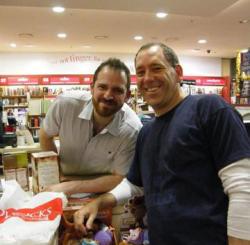Here’s a few steps that might help you in drafting and editing your novel.
1. What’s it about? Write one sentence describing your story in 25 words or less.
Yes. 25 words or less.
Rework the story to reflect this sentence, or change the sentence to reflect the story.
I’ve seen several publishers asking for this sentence in their submission requirements.
This is the point of your novel, and arguably the most important aspect of it. It’s what you’re trying to say – one side of an argument.
Without a theme your story’s just explosions and pretty sunsets. Pointless.
The theme itself is a statement. For example: “Behind every good man is a greater women.” Your story is the argument supporting either the positive or the negative side of that statement.
Think of your story as one side of the debate.
Conflict is immediate, while the threat is the potential. Work out the difference in your story.
What does your character(s) want? What are they actively pursuing? This is an external goal.
What does your character need? This will be something internal, something they aren’t likely to be aware of – a lesson to be learned, perhaps. The moral of the story.
For example, a high school student wants to be part of the ‘in’ crowd, when what they really need is to be happy with themself first.
Getting what they need will affect how they see what they want, while getting what they want before getting what they need won’t fulfill them.
What they want drives them. What they need completes them.
Getting what they need may make what they want even more worthwhile or it may render it totally obsolete. They may even have to sacrifice what they want entirely if it gives them what they need.
When they get what they need they can finally see what they want in its true light.
5. Identify the main plot points and transitions – beginning, middle, end, inciting incident, midpoint, etc.
If you don’t know what these are, and there’s lots more that I haven’t listed, I’ll be writing another post (or several) in the future covering them. For the moment though, I’ve drawn a diagram.
- Do they work to best effect?
- Can they be made to work better?
6. Chapter outline – write a brief sentence describing each chapter.
This will help you identify weak chapters or chapters that do nothing for the story.
You need to justify each chapter’s existence. Each sentence should:
- State what the chapter’s trying to convey
- Show how the chapter moves the story along.
7. Write a Cause and Effect. “Because of this, this happens. Because this happens…”
Start big, Ie:
- Beginning: Bella moves to Forks – meets Edward.
- Middle A: She’s attracted to him – discovers he’s a vampire which is part of the attraction.
- Middle B: They hook up – she becomes involved in the ‘vampire world’.
- End: Bad vampires come after Bella – Edward and family try to protect her.
Each cause has an effect, which leads to the next cause. It’s a logical progression. If you can’t find the logical progresssion, your story has a problem.
Once you’ve got the big steps down, break them into smaller steps.
Your breakdown for the beginning might be two or three pages long (although it can be much less or more). And like the big steps, it needs a logical progression. Find it.
Everything outside the cause and effect must be essential to moving the story forward in some other way.
8. Identify the big structural changes you need to make.
For example: ‘the ending isn’t satisfying enough – must rewrite to ensure the main character struggles more to achieve their goals’.
Like the example, write a list of big points that need fixing. Make these changes before going on. There’s no point in polishing text if big swathes of it might be cut or largely altered.
9. Identify the smaller but important changes you need to make.
For example:
- Make outer space/ocean/sword/city/weather more of an influential ‘player’ in the story
- Make the main character more sympathetic
- Make the antagonist appear nice at first [misdirection].
Write a list of things that need to be done, and make the changes before going on.
10. Edit the words.
Only after you’re happy with the overall structure should you start playing with words, sentences and paragraphs.
Do a complete pass from beginning to end, and once you move onto the next chapter, don’t go back until the next full pass. It’s too easy to get bogged down in the process of polishing something to imperfection. Set some sort of goal and stick to it.
11. Finally, figure out when its ‘good enough’ and get it out into the world.
If you found this post helpful, subscribe to Fandelyon.com to receive more useful posts on the craft of writing.
Like this:
Like Loading...





